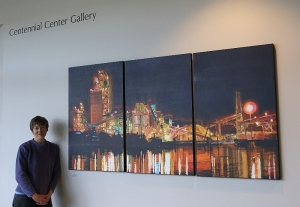My Banff residency colleague Andrew Querner has a good short interview posted on the National Post/Arts blog related to his show at the Whyte Museum in Banff. Great to see him getting this attention!
Monthly Archives: March 2012
Why gesso?
A fellow watercolorist recently contacted me through my website to ask why I use gesso under about half my work. Others may be interested in my rationale:
I don’t put gesso on watercolor paper but on something smoother and cheaper, like BFK Rives printmaking paper. In fact I often buy damaged paper on sale, because it won’t matter by the time I’m done, so long as it’s of archival quality. I usually put 2-3 coats on the side to be painted and 1-2 on the other side, so it doesn’t curl. I just slop it on with a big wet house painting brush, though I’ve tried rolling, scraping, small brush, large brush – and I saw an article in the one of the recent magazines about stamping patterns into it while it’s still wet. I’m certainly not the only person experimenting with it, and I met someone who did a thesis project on it in the late 50s!
Here are some pros and cons:
- Deep, intense color – the water evaporates and the pigments are sitting on a polymer coating instead of soaking into paper
- For pictures like The Numbers series, really wet paint slides and intermixes in unpredictable ways
- More tooth than YUPO, not ridiculously slippery
- Easy to lift or alter (though staining pigments will never go back to white)
- Easier to handle very large areas since they don’t have to be done in one quick pass, and the surface stays flatter. I wrapped some 76 x 51-inch pieces around live trees. They’re gesso’d and varnished – I’d never do that with watercolor on traditional paper; too big a risk they’d be ruined by moisture.
- Possible to layer with interesting effects, e.g. a thinner layer on top of a thicker layer of paint will crawl with useful textures (see the sky in Iterated Cranes)
- Possible to rub back in with a damp rag for an almost fresco surface (and why I like to brush rather than roller the gesso). See the sky in The Joints of Cranes or Across the Water.
- Makes a strong presentation when mounted on panel and spray varnished, rather than traditional matting and glazing. Equal in presence to an oil painted canvas on the wall.
On the other hand:
- it’s harder to get soft edges and transitions
- it’s hard to impossible to get smooth washes
- the pieces are more fragile until varnished
- the process wears down brushes faster. I keep 2 sets, one for gesso and one for watercolor paper.
- it takes more prep time, so it’s a little less spontaneous.
- I’ve experimented with partial gesso, but haven’t found it to be very noticeable.
